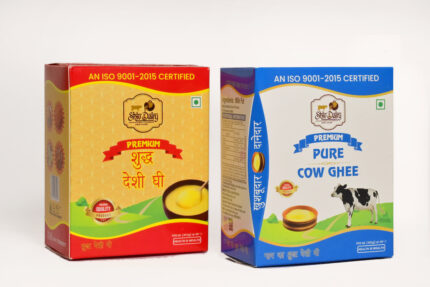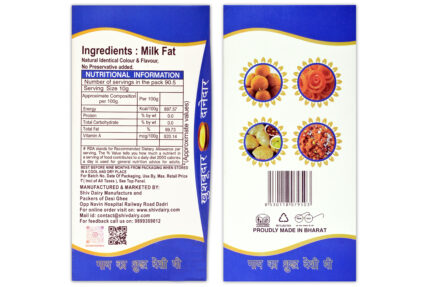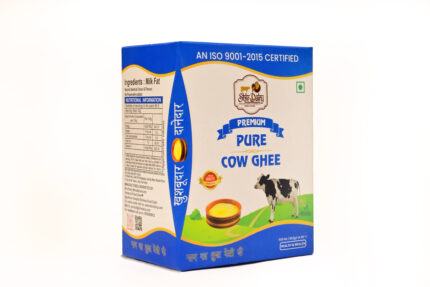Buffalo Desi Ghee Carton (1 L) Made by Traditional Method
Buffalo ghee is type of clarified butter,made from the milk of buffaloes. It’s particularly popular in parts of South Asia, like India, where buffalo milk is more common due to the animal’s higher milk yield and fat content.buffalo butter is simmered to remove water, milk solids, and impurities, resulting in a pure, golden fat with a distinct flavor.buffalo ghee has a higher fat content—typically around 70-75% saturated fat—because buffalo milk naturally contains more fat 7-8%. This gives it a richer, creamier texture and a slightly more intense, earthy taste. It’s still lactose- and casein-free, with a high smoke point (around 485°F or 250°C), making it versatile for frying, sautéing, or tempering spices. Nutritionally, it also contains fat-soluble vitamins (A, D, E, K), though the exact profile can vary based on the buffalo’s diet and breed.In terms of uses, buffalo ghee is a staple in many regional cuisines. In North India, for example, it’s often preferred for making heavy dishes like parathas, halwa, or rich curries, as its robustness complements bold flavors. Some claim it’s more “cooling” for the body in Ayurvedic terms, though this is traditional wisdom rather than science-backed. Health-wise, it’s similarly calorie-dense (around 115-120 calories per tablespoon) and should be consumed in moderation due to its high saturated fat content, which could impact cholesterol levels if overdone.One practical difference is its appearance and shelf life. Buffalo ghee tends to be whiter or less golden than cow ghee due to lower carotene levels in buffalo milk, and its higher fat content can make it slightly thicker. It also keeps well without refrigeration.
Buffalo Desi Ghee Carton (1.5 L Pack) Made by Traditional Method
Buffalo Desi Ghee Carton (500 Gm) Made by Traditional Method
Buffalo Desi Ghee Combo Carton (1,1 L) Made by Traditional Method
Combo of Cow & Buffalo Ghee Carton (500,500 ML) Made by Traditional Method
Cow Ghee Carton (1 L) Made by Traditional Method
Cow ghee, often simply referred to as ghee, is a type of clarified butter that originated in ancient India and is widely used in Indian cuisine, Ayurvedic medicine, and cultural practices. It’s made by simmering butter from cow’s milk to remove water, milk solids, and impurities, leaving behind a golden, pure fat with a rich, nutty flavor.In terms of composition, ghee is primarily saturated fat (about 60-65%), with smaller amounts of monounsaturated and polyunsaturated fats. It contains fat-soluble vitamins like A, D, E, and K, and has no lactose or casein, making it a popular choice for those with dairy sensitivities. The smoke point of ghee is high—around 485°F (250°C)—which makes it great for cooking at high temperatures without burning, unlike regular butter.In Ayurveda, cow ghee is prized for its supposed health benefits. It’s said to aid digestion, boost immunity, and nourish the body when consumed in moderation. Some studies suggest its conjugated linoleic acid (CLA) content might have anti-inflammatory properties, though evidence is mixed and more research is needed. On the flip side, its high saturated fat content means it’s calorie-dense (about 112 calories per tablespoon), so overconsumption could contribute to heart health risks if not balanced with an otherwise healthy diet.Culturally, ghee holds a special place in India. It’s used in religious rituals, like lighting lamps or as an offering, and is a staple in dishes like dal, roti, or sweets like laddoos. Traditionally, it’s made from the milk of indigenous cow breeds (like Desi cows), which some claim enhances its quality due to differences in milk composition, though this is more anecdotal than scientifically proven.









